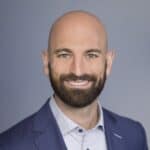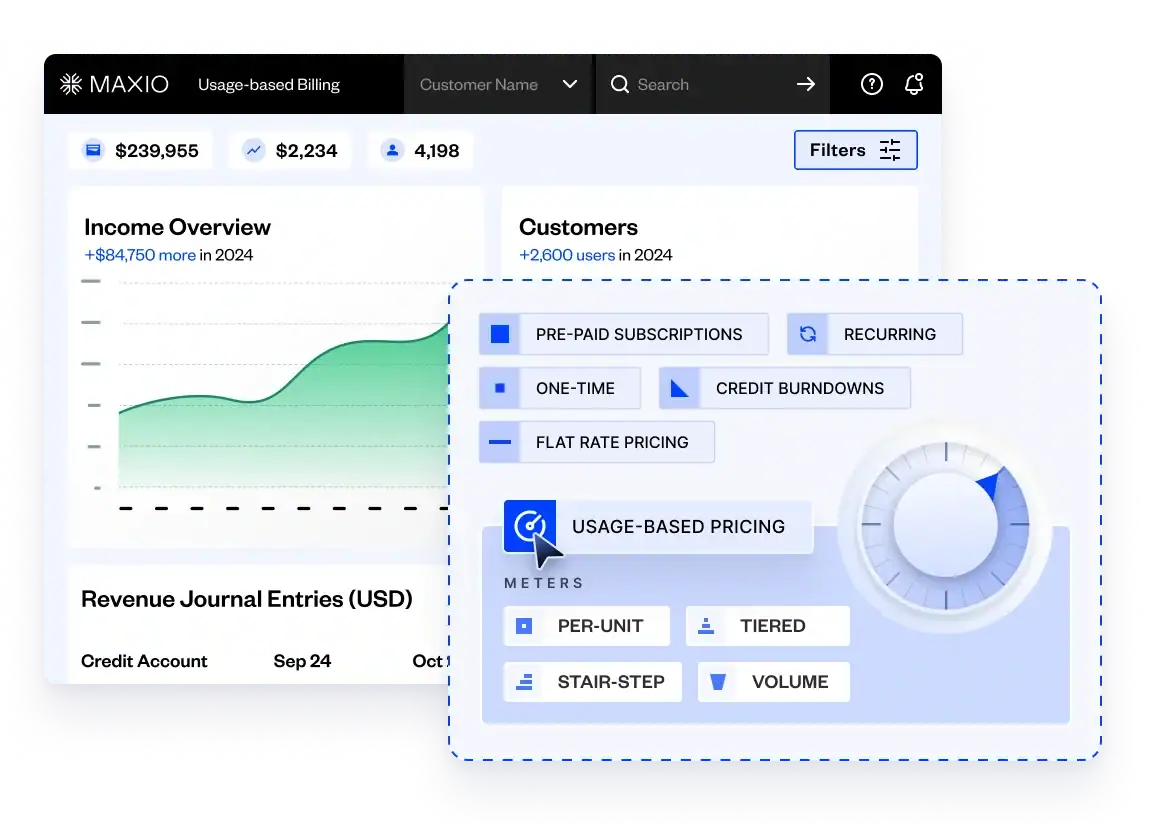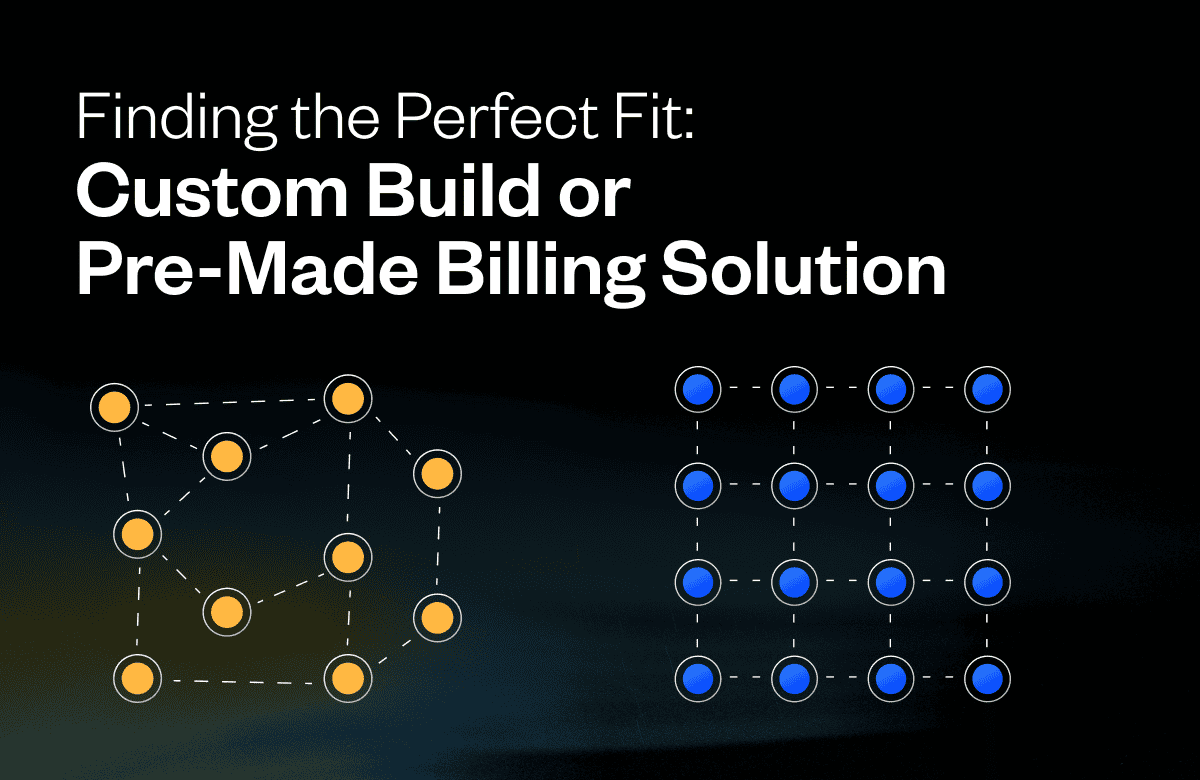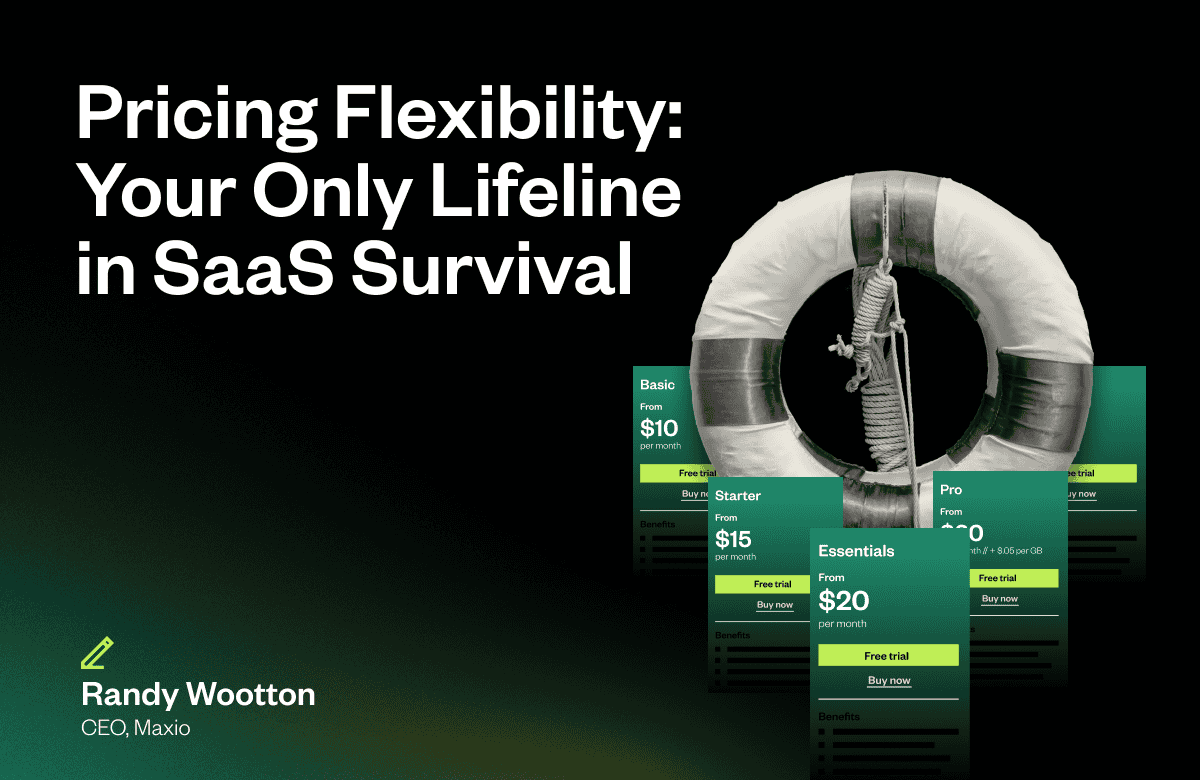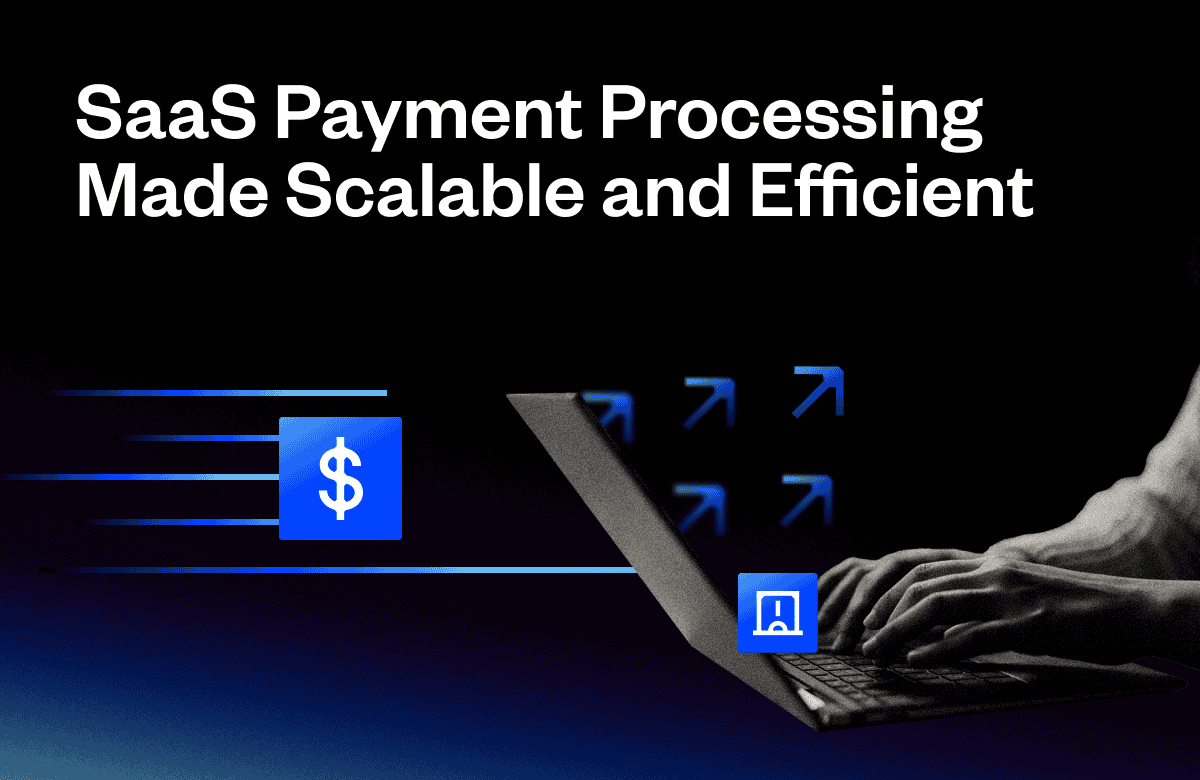The pricing models your SaaS company uses have a big impact on your revenue. Here’s a breakdown of the most common pricing models and strategies—and how to use them effectively.
Developing the right pricing is critical if you’re trying to build a profitable SaaS company. To be successful, you need a pricing strategy that appeals to your customers and captures the full value of your product or service. Narrowing in on the ideal product pricing for your SaaS is challenging, and getting it wrong can result in unnecessary revenue leakage.
Your prices should attract new customers and help reduce the churn rate of existing customers, while ensuring you set the optimal price that maximizes value without risking prices being too low.
To strike the right balance, you need more than the right price—you need the right pricing model. This guide explains the difference between pricing strategies and pricing models, then walks through the most common options and how to use them effectively.
Defining pricing strategy vs pricing models for services
When you research different pricing options, you will often hear the phrases pricing strategy and pricing model. These phrases overlap—they both help you find a price point that will maximize the lifetime value (LTV) of your customers. But there’s a key distinction between these concepts:
- Pricing Strategy: Your business develops a pricing strategy internally based on its goals, the competition, and the expectations of potential customers. Your pricing strategy influences which pricing model(s) you select, and it also helps you determine the best price point for your products or services.
- Pricing Model: This refers to the format or template you use for your prices. The pricing model is externally facing. Although you may use different price points, the same model applies to all of your products and services. You may charge a different price for a new product, for example, but you will use the same model as you do for your other products.
Your pricing strategy will affect the pricing model and the price points that you select. Your strategy will outline the metrics you want to hit, and then, your pricing model will help to ensure you hit those metrics.
For example, the most common SaaS pricing strategy is a subscription-based pricing model. This gives customers the perceived value of constant access to your software at a predictable set price every month. At the same time, it provides a higher-than-average gross margin. KeyBanc reports that while the total gross margin of SaaS companies was 73% over the last two years, and the median subscription gross margin was 77 to 80%.
Top 5 product pricing strategies
To hone in on the right strategy, you need to consider a wide range of questions. What do your customers want? What is the competition doing? What prices can the market bear? What prices do you need for growth? You can’t just focus on a dollar amount alone. There are all kinds of different ways to price a product, and if you want to be as profitable as possible, you need to understand the different types of pricing strategies.
Value-based pricing
What is your customer willing to pay? How much value do they place on the service you are providing? Answering these questions is the most important part of a value-based pricing strategy. With this pricing model, you base your price on the value of your product to your customers, not on your production costs.
This requires you to study your target market very closely. You must get to know them to determine exactly how much they’re willing to pay based on the product’s value to them. Businesses that use this pricing strategy could often choose to charge more, but they build loyalty by charging rates that align with their customer’s desires and expectations. The challenge of value-based pricing is that you have to be very in tune with your customers, and you must stay aware of changes in the marketplace.
This pricing strategy is ideal for a SaaS business that is tuned in to the needs of its customer base and is able to generate a significant ROI for their users.
Premium pricing
Not all target markets want the lowest prices. Many want value, and they’re willing to pay a high price for it. Premium pricing relies on the rule that the best price isn’t always the lowest price. It taps into the idea that solving a very specific problem better than anyone else allows you to charge a higher price.
SaaS businesses that use premium pricing often leverage their unique selling points to charge higher prices. This pricing strategy is very common in mid to late-stage SaaS companies that have achieved product market fit and have a competitively differentiated product offering.
Bundle pricing
Bundle pricing allows you to offer multiple products or services together at a price lower than if they were purchased separately. This creates added value and encourages customers to buy more than they originally planned. When done right, bundling can make your offerings seem more attractive, ultimately increasing your overall sales.
For SaaS businesses, bundle pricing works especially well when you group essential features or services into one package. It can also improve customer retention by giving users access to extra features they might not have purchased individually. Over time, bundling can help solidify customer loyalty and increase revenue.
Dynamic pricing
Dynamic pricing allows you to adjust your prices in real time based on factors like demand, competition, or customer behavior. This flexibility helps you optimize revenue by aligning prices with market conditions. It’s particularly effective in industries where demand fluctuates or customer preferences change frequently.
For SaaS businesses, dynamic pricing can be especially valuable when usage varies or when there’s competition driving price sensitivity. This model lets you make adjustments as necessary, but it’s important to closely monitor market trends and customer actions to get the best results.
Competitive pricing
With competitive pricing, you don’t consider the cost of production or consumer demand. Instead, you base your prices around the competition’s prices. You may select prices that are the same or lower than the competition, or you may price your offerings slightly higher in exchange for offering more value or better features.
Competitive pricing works best in highly saturated industries where consumers have a lot of choices between similar products.
Top 10 most common types of pricing models
Once you’ve settled on a pricing strategy that fits your business goals, the next step is choosing a model that supports that strategy. Here are the different pricing models that SaaS companies commonly use.
Flat-rate pricing
Flat-rate pricing is a set price for access to your SaaS product. Customers pay a certain price for your service plus set amounts for any add-ons. The price itself is often influenced by the cost of providing the service, but it’s even more closely tied to the value of the service.
For example, business professionals such as attorneys and accountants often charge flat rates for different types of services, but SaaS companies that provide streaming services or different types of software providers also use flat rates on a subscription basis.
Tiered pricing
The tiered pricing model uses different price points for different features or subscription levels. This allows you to provide unique offerings at different price points based on the needs of your target customers. It also builds inherent opportunities to upsell over time.
A new customer will often start on the lowest tier. This could even be a freemium offering. Then, once they need more functionality or a different set of features, they can just jump up a level. Your offerings take customers through various stages of the customer lifecycle.
SaaS companies often use tier pricing when creating their subscription pricing, but you also see this pricing model from companies that offer food delivery, cable TV services, and consumer goods.
Per-user pricing
This pricing model charges based on the number of users. Customers pay a set fee for every person that’s going to access the product. When determining the fee, businesses take into account cost, value, competition, and many of the other concepts discussed above.
Consumers like this model because they only have to pay for what they need. If they only have one active user, they pay a lot lower price than if they have multiple users. Businesses gravitate toward this model because it’s easier to calculate the target price. It’s also easier to make revenue predictions when compared to usage-based pricing.
Per-user pricing is very popular with software companies, but it’s also found at amusement parks, movies, and throughout the entertainment industry.
Usage-based pricing
With usage-based pricing, the price depends on how much the customer consumes. The more they use or consume, the more they will pay. Customers often prefer this pricing model because it’s linked directly to the value they’re receiving in return.
However, there are two main challenges with this pricing model. Ray Rike sums them up as:
- Forecast management: “How does the vendor accurately predict the usage?”
- Customer reaction to overuse: “When [the user] exceeds their projected usage levels and has not adequately budgeted for the actual usage levels.”
If you adopt this model, you have to consider both of those elements as well as all of the other dynamic market factors that affect demand. Many software companies use this model, and it’s long been the standard for utility companies.
Freemium pricing
In some cases, the most competitive price is $0. Offering free trials or basic versions of your product lets customers test out your offerings. Freemium pricing shows your customers what you can do for them, and it builds trust. Offering a free version also creates awareness of your product in the marketplace—this approach is most common among product-led SaaS companies.
Although it may seem counterintuitive, freemium pricing can greatly help to grow your market share and enhance your profitability. For instance, SaaS companies that offer a robust free product often recover their customer acquisition costs in about 75% of the time that it takes companies that don’t offer free trials.
Freemium pricing also allows SaaS companies to build out their initial user base before executing cross-sell and upsell tactics. SaaS companies often use this strategy, but businesses across all kinds of industries often give up freebies as a marketing hook or in exchange for new customers as well.
Cost-plus pricing
This pricing model starts with the total cost of developing and maintaining your SaaS, and then it adds on a certain margin. For instance, if it costs $20 to make a widget and you want a 20% profit margin, you would charge $25. To put it another way, you would mark up production costs by 25%. This is also called markup pricing.
This pricing model isn’t ideal for SaaS companies as their products tend to provide significantly more value than the cost of producing them. Businesses that sell physical products tend to use cost-plus pricing the most.
Penetration pricing
Penetration pricing starts with a low price point to attract users quickly and build market share. This model is commonly used by new SaaS products looking to gain traction in a competitive space. By offering a lower price than the competition—or even a limited-time free plan—you reduce the barrier to entry and encourage faster adoption.
While this model can drive rapid growth, it’s not usually sustainable on its own. The goal is to eventually raise prices once you’ve built trust and proven value. That means you need a clear plan for transitioning customers to a higher price point without creating churn. It works best when paired with strong onboarding, excellent support, and a product that keeps users engaged over time.
Price skimming pricing
Skimming pricing begins with a high price at launch, aimed at customers who are willing to pay more for early access to something new, premium, or exclusive. It’s a way to maximize revenue from early adopters—especially when you’re offering features that aren’t available anywhere else or when you’re entering the market with little direct competition.
As time goes on and demand starts to broaden, you gradually lower the price to reach a wider audience. This approach helps you capture value from each stage of the product lifecycle and works well for SaaS products that launch with standout functionality or major updates. It’s especially useful when your initial customer base places high value on being first, and your long-term plan includes expanding access as competition grows or features become more standard.
Feature-based pricing
This model charges customers based on the specific features or capabilities they unlock, rather than usage, users, or access levels. It often overlaps with tiered pricing but gives you more control over which individual functions are gated behind different price points.
Feature-based pricing works best when your product has distinct capabilities that different customer segments need. For example, smaller teams might only need basic automation, while enterprises might pay more for advanced analytics, integrations, or custom workflows. This model supports customization and lets you tie price directly to perceived value and customer needs, especially as your product evolves.
Pay-as-you-go pricing
Pay-as-you-go pricing lets customers access your product without a subscription or fixed plan—they’re only billed when they choose to use it. Unlike usage-based or metered billing, which often runs in the background as part of a recurring plan, pay-as-you-go doesn’t require ongoing access or automatic charges. It’s more transactional, and the customer stays in control of when and how they use the product.
This model works well for SaaS products that offer tools or services people use occasionally or in bursts, rather than every day. It lowers the barrier to entry and gives users more flexibility, making it especially appealing for small teams or individual users. While it may lead to less predictable revenue, it can expand your user base quickly if your product solves a clear, on-demand need.
Considerations when selecting the right pricing model and strategy
With so many pricing options, it can be hard to even know where to start. Ultimately, there is no one-size-fits-all solution. The best subscription billing pricing strategy varies based on your business model and goals.
A small business providing consultancy services to a handful of clients, for example, may have a vastly different pricing structure than a manufacturer who sells millions of products to millions of people. Similarly, SaaS companies need to use a different pricing structure than companies that focus on tangible products or traditional services.
You also have to take into account your target market and look at what the competition is doing. In particular, you should consider the following in your decision-making process.
- Buyer persona: Who is going to buy your product? What do they want? What are they willing to pay? Ideally, your product should solve a problem for your target buyer, and it should have a price point that appeals to their desire for value, luxury, or other intangibles.
- Competitor pricing: Even if you don’t use a competitive pricing model, you should research your competitors’ prices. Then, look behind cost and think about the elements that differentiate you from the competition.
- Messaging: Your messaging shapes how your customers interpret your prices, and it can be even more important than the actual price itself. According to Bryan Belanger, “Any consternation on these types of [pricing] changes is largely due to the rollout messaging, not the actual changes.”
Should you choose a basic markup strategy for your products? Should you choose a flat rate for your services? Should you embrace tiered pricing for your SaaS pricing models? Choosing the right template can be challenging.
You need to look at the competition and think about what your target market expects, but then, in some cases, you may want to disrupt expectations or offer something better than the current trend. To strike the right balance, you need a partner that allows you to offer various pricing models based on your needs.
Optimize your SaaS subscription pricing models with Maxio
After you select the right pricing model for your product and business goals, the real work begins. You need to monitor performance, track key metrics, and make adjustments as your business grows. It’s also important to make sure your pricing aligns with your brand image and communicates value clearly to your customers.
Maxio makes this process easier with automated billing software, CPQ functionality, and SaaS reporting tools, helping you manage subscriptions, collections, and revenue operations more effectively.
Ready to optimize your pricing? Schedule a demo to see how Maxio can support your business.

